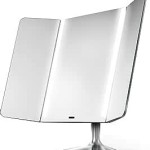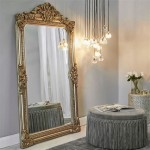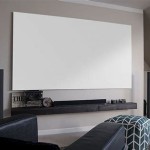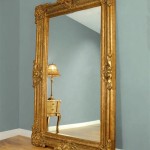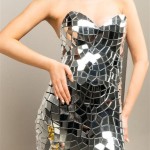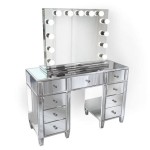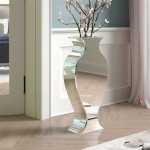Framing a Mirror
Framing a mirror elevates its appearance, transforming it from a simple reflective surface into a decorative element. A well-chosen frame can complement existing décor, enhance the mirror's size and presence, and protect its edges from chipping and damage. The process of framing a mirror, while achievable for DIY enthusiasts, requires careful planning and execution to ensure a professional and aesthetically pleasing result.
The initial step involves selecting the appropriate frame. Various materials are available, each offering distinct aesthetic qualities and practical considerations. Wood frames provide a classic, versatile option, adaptable to numerous décor styles. The type of wood, its finish, and any carving details will significantly influence the final look. Metal frames, often aluminum or steel, offer a contemporary feel, while ornate, gilded frames can lend a touch of traditional elegance. Synthetic materials, such as polystyrene or polyurethane, provide a lightweight, cost-effective alternative, often mimicking the appearance of wood or plaster.
The frame's dimensions are crucial. It should adequately cover the mirror's edges while providing sufficient visual border. The width of the frame should be proportionate to the mirror's size; a large mirror can accommodate a wider frame, while a smaller mirror benefits from a narrower frame to avoid overwhelming the reflective surface. The frame's depth is equally important. It must be deep enough to accommodate the mirror's thickness, ensuring a flush fit against the wall.
Measuring the mirror accurately is paramount for a successful framing project. Precise measurements ensure the frame fits snugly and securely. Using a tape measure, record the mirror's height and width, taking measurements at multiple points to ensure consistency. These measurements will determine the required frame dimensions.
Once the frame is selected and acquired, the next stage involves preparing the mirror for framing. Thoroughly clean the mirror's surface with a glass cleaner to remove any dust, fingerprints, or residue. This ensures a clear, unobstructed reflection once the framing is complete. Protecting the mirror's surface during the framing process is essential. Laying down a soft cloth or protective covering can prevent scratches and other damage.
Several methods exist for securing the mirror within the frame. One common approach utilizes mirror clips, small metal or plastic brackets that grip the mirror's edges and hold it in place against the frame's backing. These clips are typically affixed to the frame's inner edge and provide a secure, adjustable hold. Another method involves using adhesive, specifically formulated for mirrors, applied to the frame's backing before positioning the mirror. This method provides a permanent bond but requires precise placement to avoid uneven adhesion.
Adding a backing board provides additional support and protection for the mirror. This backing, often made of thin plywood or hardboard, helps to distribute weight evenly and prevent flexing, which could damage the mirror. The backing board is cut to fit within the frame's interior dimensions and secured to the frame using adhesive or small nails.
Finishing touches can significantly enhance the framed mirror's overall appearance. Consider adding decorative elements, such as molding or trim, to the frame's exterior. These additions can complement the frame's style and add visual interest. Applying a sealant to the frame's edges can protect it from moisture and other environmental factors, extending its lifespan. Attaching hanging hardware, such as D-rings or wire, to the backing board allows for secure and stable wall mounting.
Proper installation is key to showcasing the framed mirror effectively. Choose a location that complements the mirror's size and style, considering factors such as lighting and surrounding décor. Ensure the wall can support the combined weight of the mirror and frame. Use appropriate hanging hardware and mounting techniques to ensure the mirror is securely fastened to the wall, preventing accidental dislodging or damage.
Different types of mirrors may require specific framing considerations. Antique mirrors, for instance, often benefit from specialized framing techniques that preserve their historical integrity. Large, heavy mirrors may necessitate reinforced framing and more robust hanging hardware. Beveled mirrors require frames that accommodate the beveled edge, ensuring a proper fit and showcasing the bevel's decorative effect.
Regular maintenance can preserve the framed mirror's appearance over time. Dust the frame and mirror surface regularly with a soft cloth. Avoid using abrasive cleaners that could scratch the frame or mirror. Inspect the frame periodically for any signs of damage, such as chips or cracks, and address them promptly to prevent further deterioration. Reapply sealant to the frame as needed to maintain its protective barrier against moisture and other environmental elements.

How To Frame A Mirror

Mirror Frame Diy How To Update A Basic Bathroom Our Faux Farmhouse

How To Frame A Mirror Sand And Sisal

How To Install A Mirrorchic Bathroom Mirror Frame Momhomeguide Com

Diy Stick On Mirror Frame Sawdust Sisters

How To Frame Out That Builder Basic Bathroom Mirror For 20 Or Less

Diy Bathroom Mirror Frame With Molding The Happier Homemaker

How To Make A Diy Bathroom Mirror Frame Thediyplan

How To Build A Wood Frame Around Bathroom Mirror Young House Love

Mirror Frame Diy How To Update A Basic Bathroom Our Faux Farmhouse

